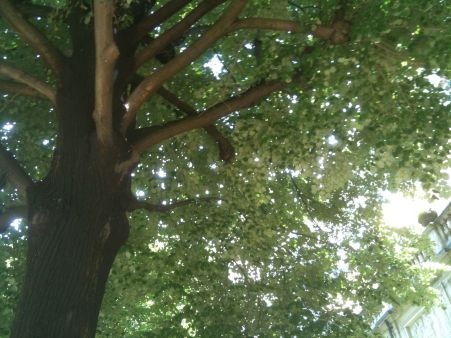There are facial recognition apps and music identification apps, but what I need is a Shazam for plants. I imagine holding up my iPhone to flowers, fruits, leaves and branches, to flash on their names in Latin (or any other language), with links to all sorts of information. In the meantime, I snap photos and text them to my patient and talented landscape-architect and gardening friends: Jeannene, or Rosalynn, or Suzy.
I spent most of the month of June under a canopy of linden, though I didn’t know it. For several days in a row, cutting through a little square between my apartment in Vieux Lyon and the Saône River, I would get a strong whiff of what I thought was Roger and Gallet Fleur de Tilleul body lotion–a long-time favorite. I was baffled. The linden products had not made the cut when I was slimming down my suitcase. Nonetheless, each time I got a blast of that heady, honeyed, leafy bouquet, I would give my arm a furtive sniff, just to be sure I wasn’t exhaling some mysterious eau de Combray.
The perfume was everywhere–on street corners, in public gardens, in museum courtyards. I sniffed my sleeves in blissful ignorance. So strong was the aroma one day, that I was convinced the fragrance had either been added to those heavy-duty street-washing machines, or that it was pumped out of a shop by some enterpreneurial smell-lover à la Abercrombe and Fitch. Though I’d used those Roger et Gallet products for years, and admired Bond’s Eau de Noho precisely for the linden note, I wouldn’t have known a linden tree if I tripped over it (which, by the way, I once did). Then one day, as my eyes followed a massive tree trunk skyward to a fresh blanket of leaves and whitish blossom clusters directly above me, it hit me: I knew the smell, I knew the tree and I knew the word, but I had never connected the three. There was something satisfyingly temps retrouvé about finally putting it all together–like when Marcel has his epiphany about the not-so-separate ways of Swann and Guermantes. The waiter working in the absinthe bar under the tree could not confirm my positive linden ID. I texted one of my Plant Muses just to be sure.
I was once the kind of reader who looked up mentions of arcane clothing and decor in the Petit Larousse Illustré (and later on line), who sought out place names on maps, but who would blithely skim over unfamiliar smell words. When I first encountered Baudelaire’s Correspondances (a sonnet famously anchored in its base notes of musk, amber, benzoin and incense) (1), a classmate asked the professor what benjoin smelled like. The query seemed indulgent, even frivolous in the theoretical, methodological context of a linguistic turn that shaped our discussions at the time. The reply: tar. Yes, Fragrant Reader, tar. No doubt a dictionary consultation had led to this inadvertent correspondance: a confusion of benzoin compound (said to smell camphorous–I haven’t done the field work) and the sticky styrax benzoin tree ooze recommended in nineteenth-century perfume manuals (along with ambergris, tolu, storax, and so on), as fragrant fixatives to stabilize more volatile floral notes. I hesitate to admit that it took me over a decade to discover the smooth, almost vanillic (yet not), almost almondy (yet not) resin delight that is benzoin.
Since I’ve now inhaled musk, amber, benzoin and incense in many iterations, the Baudelaire poem has new depth and dimension for me–not only sensorial, but cultural, historical, geographical, philosophical, aesthetic. Today I get distracted if I read an odor I cannot identify. Smell words taunt me until I hunt them down and breathe them in. It is no secret that I advocate scratch-and-sniff literature; but I guess what I really need is an olfactory-identification app for reading.
(1) Richard Stamelman reads the poem in terms of perfume in Perfume: Joy, Obesession, Scandal, Sin. A Cultural History of Fragrance from 1750 to Present (114-115).




